POSTCARD FROM CATALUNYA–Mare Nostrum, Sitges–Very Good Catalan Seafood Cooking, B+
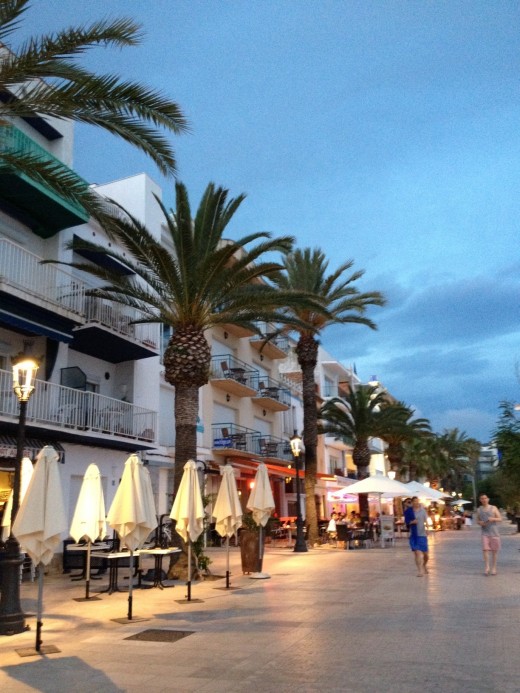 On the waterfront: Sitges
On the waterfront: Sitges
My discovery of Catalan cooking dates to an almost comically unsuccessful stint as an English teacher in Barcelona in the mid-eighties. I had a gap between two jobs in New York and a close friend’s brother, who was then living in Barcelona, told us a school there was looking for two native English speakers to run English conversation classes. My pal had a two-month hole in his schedule, too, so we applied and were hired despite the fact that neither of us had any teaching experience. The school specialized in teaching business English to executives, so reporting to work on our first morning on two hours of sleep and with nearly medical hangovers, we discovered that we were expected to wear jackets and ties at the school–a problem, since neither of us had brought either, and that there were two classes, one for men and one for women. It seemed a no-brainer to me that the women would be easier and more fun to teach than the men, and since my friend came to the same conclusion, we flipped a coin, and I lost.
There was an open communicating door between the two classrooms, so I could see and hear what my friend was up to, and I knew that things weren’t going very well when I heard him pose the following question to his ladies: “Do you like birds?” Silence was the appropriate response to this gambit, and silence was what he got. Meanwhile, my besuited men emitted a pleasant fugue of Puig Agua Lavanda and were shy and very polite. I explained, with major omissions, who I was and where I was from, and offered up that this was my first visit to Barcelona, a city I found very beautiful. Murmur of appreciation. Then I asked them what I should see in their city while I was there. A few murmured responses–Sagrada Familia, etc. Next I heard myself saying, “Do you like to barbecue in Catalunya?” My friend next door whopped with laughter at this one, but until you’ve tried you’d striking up a conversation with a room full of total strangers in dark suits old enough to be your father, I’d suggest you hold your fire. To my great surprise, someone raised his hand. “We do like to barbecue, and right now is the season of the calçots,” said a good-looking older man in the front row. Calçots? “Special onions of the springtime.” Now someone else joined in. “We make them grilled and mother (sic) them with romesco.” Romesco? (a delicious Catalan mortar-made sauce of almonds, peppers, garlic, olive oil and sometimes tomatoes) But how to mother them? “You roll the onion in the sauce like a baby.” But of course you’d never smother a baby.
Soon we were well out of the gate, since I’d inadvertently found a subject that impassioned this room full of accountants, copy writers and lawyers. They told me where to go to eat calçots, which are indeed delicious, and they became my tutors in one of the Mediterranean’s great kitchens, since they’d come to our morning classes with restaurant recommendations written down on little scraps of paper and deliver oral recipes for their favorite dishes. Meanwhile, next door, I was still hearing things like, “Do you like cats or dogs?, which was almost the equivalent of a phrase from a German-English phrasebook my grandmother owned, which had became a family joke: “Excuse me, Madame, but there’s a cinder in your hat.”
Some years later, my fledgling knowledge of Catalan cooking got a big boost when I met Marimar Torres, the California winemaker from the distinguished Vilafranca de Penedes wine family, while I was doing a story on her family for a nice and now sadly defunct wine-country living magazine based in Napa, California. She cooked a superb lunch for me at her family’s house in Sitges and gave me a copy of her wonderful cookbook, Catalan Country Cooking, which I worked my way through in my kitchen in Paris over the course of the following year.
Despite my best efforts, however, many of the dishes in this book taste much better in situ, because the ingredients they require are not easy to find in Paris, so I always keenly look forward to my trips to Catalunya for the chance to eat its wonderful food.
Unsurprisingly, it’s not always easy to find really good and authentic cooking in the more tourist-oriented beach towns along the Catalan coast, and this is why I was so looking forward to dinner with friends at the restaurant Mare Nostrum in Sitges the other night. This table had come highly recommended by several of the delightful people at the terrific Pares Balta winery in Vilafranca de Penedes and had also been confided to me by the butcher where I shop when Bruno and I are on holiday by the seaside. The egg lady in the market had mentioned it, too, so when we decided to meet our South African pals for dinner, we booked here.
Arriving, it was a jaunty looking place with a taut white awning equipped with ceiling fans sheltering a terrace with well-spaced tables mostly occupied by handsomely groomed Catalan couples and families–the sartorial reflex to a certain relaxed formality in Spain is a wonderful visual tonic, and the welcome was warm. Sliced salami and good warm bread with a bottle of excellent olive oil arrived immediately, and I instantly had the sense of being in a very well-run restaurant with a sincere desire to please. Bruno and I try to eat our arroz (rice) dishes or fideus (short vermicelli) dishes at noon, but the South Africans had just arrived in Spain, so we agreed to throw the dice for rice, which was the only way to decide which one we’d eat, since everyone wanted something different, they’re served for a minimum of two, and they’re even better when made for four.
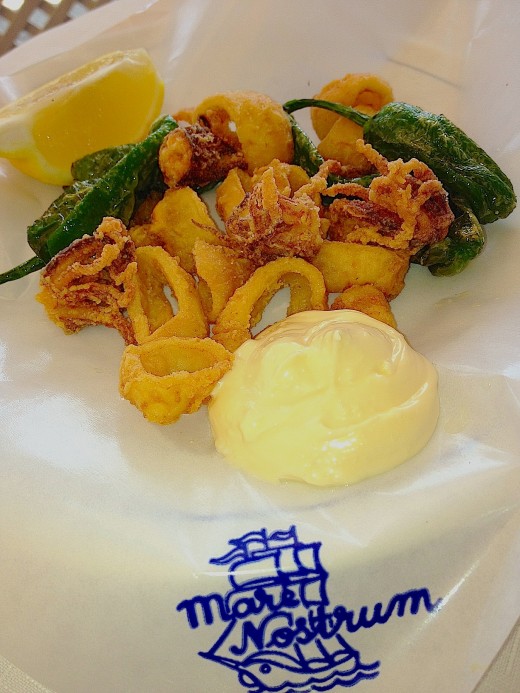
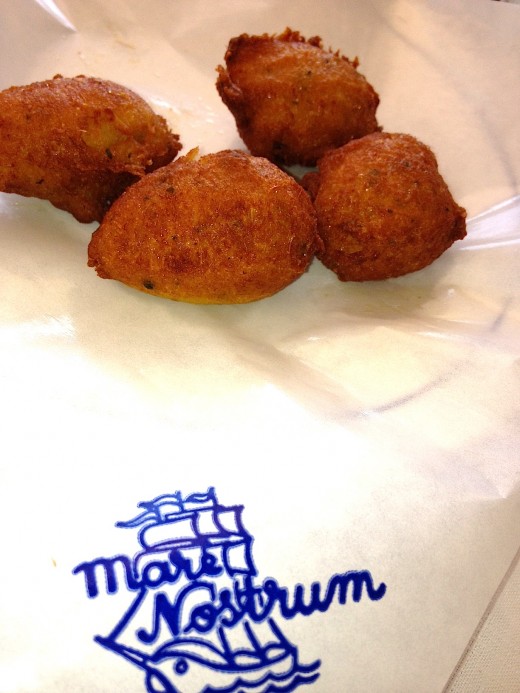
First, though, some nibbles, and they were wonderful–a mix of tender battered baby squid and flash-fried pimientos de padron, those delicious little green peppers from Galicia that you eat whole, and some delicate, perfectly fried and surprisingly airy salt-cod fritters. With a bottle of chilled 100% xarel lo (local cepage) from nearby Vilafranca de Penedes, the meal was off to an excellent start.
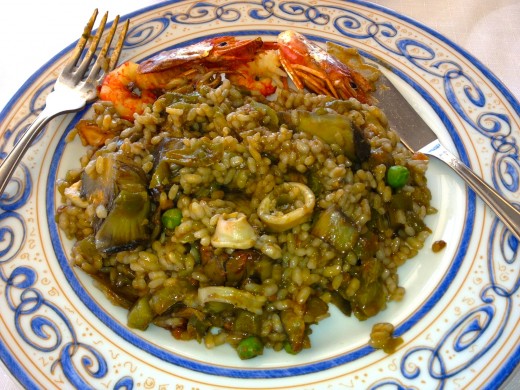
The rice dish was outstanding, too. Cooked in fish stock, the short grain rice from Valencia was still al dente and was an unctuous casserole generously garnished with tender baby artichoke hearts, squid, peas, and peppers, with two rather overcooked prawns on the edge of the plate for decoration. Unlike many Catalan rice dishes, this one came without aioli, but it was so richly flavored and even a little sweet from the artichokes that aioli would have been gilding the lily. Next week when I’m back in woefully rainy Paris, I know this dish will come to mind someday when I’m holding a dripping umbrella in a crowded Metro car, because for me, the best souvenirs you can take home from any holiday are always gastronomic.
After we’d finished slices of homemade fig tart, one of the charming owners of this restaurant served us complimentary shots of some local firewater that went down easily after such a hefty feed, and we learned that this restaurant opened in 1950 and is now run by the third generation of the Marti family, who have an exceptional gift for hospitality. This is the seaside restaurant you always hope you’ll find while you’re on holiday, so special thanks to Maxime Bazart for the wonderful recommendation.
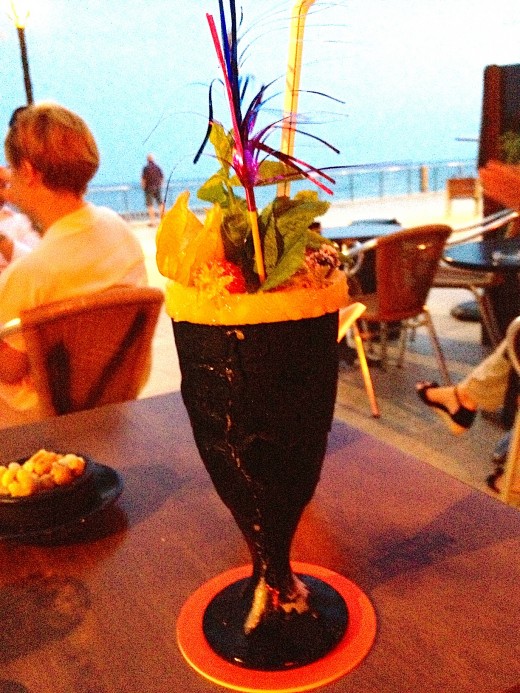
Now if only I could break Bruno of his penchant for elaborate post-dinner cocktails…. But then again, he probably wanted to fling my snifter of very good brandy over the railing, too, and happily we were walking home.
Passeig de la Ribera 60, Sitges, Tel. (34) 93-894-3393, www.restaurantemarenostrum.com, Closed Wednesdays, Average a la carte 50 Euros.




